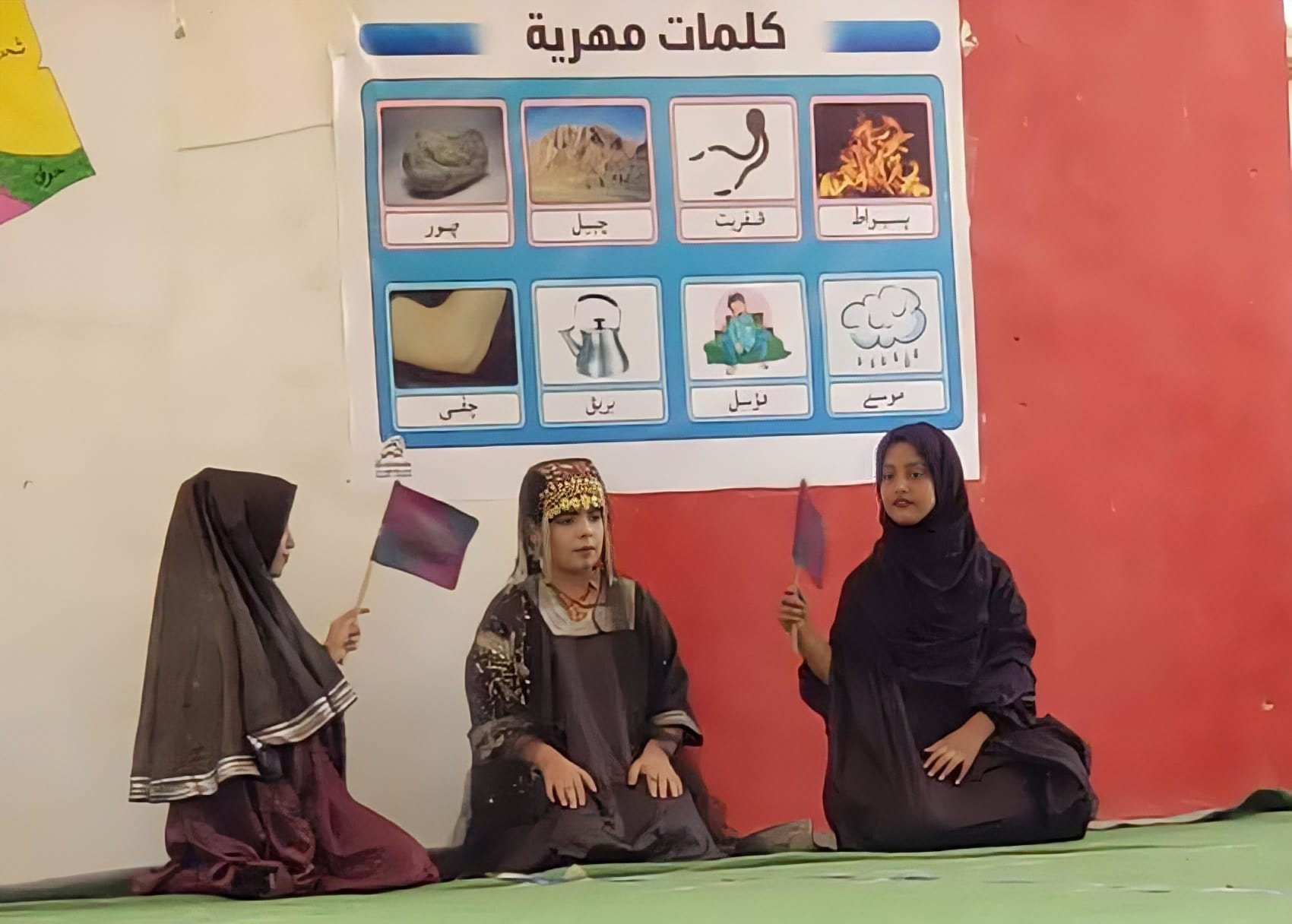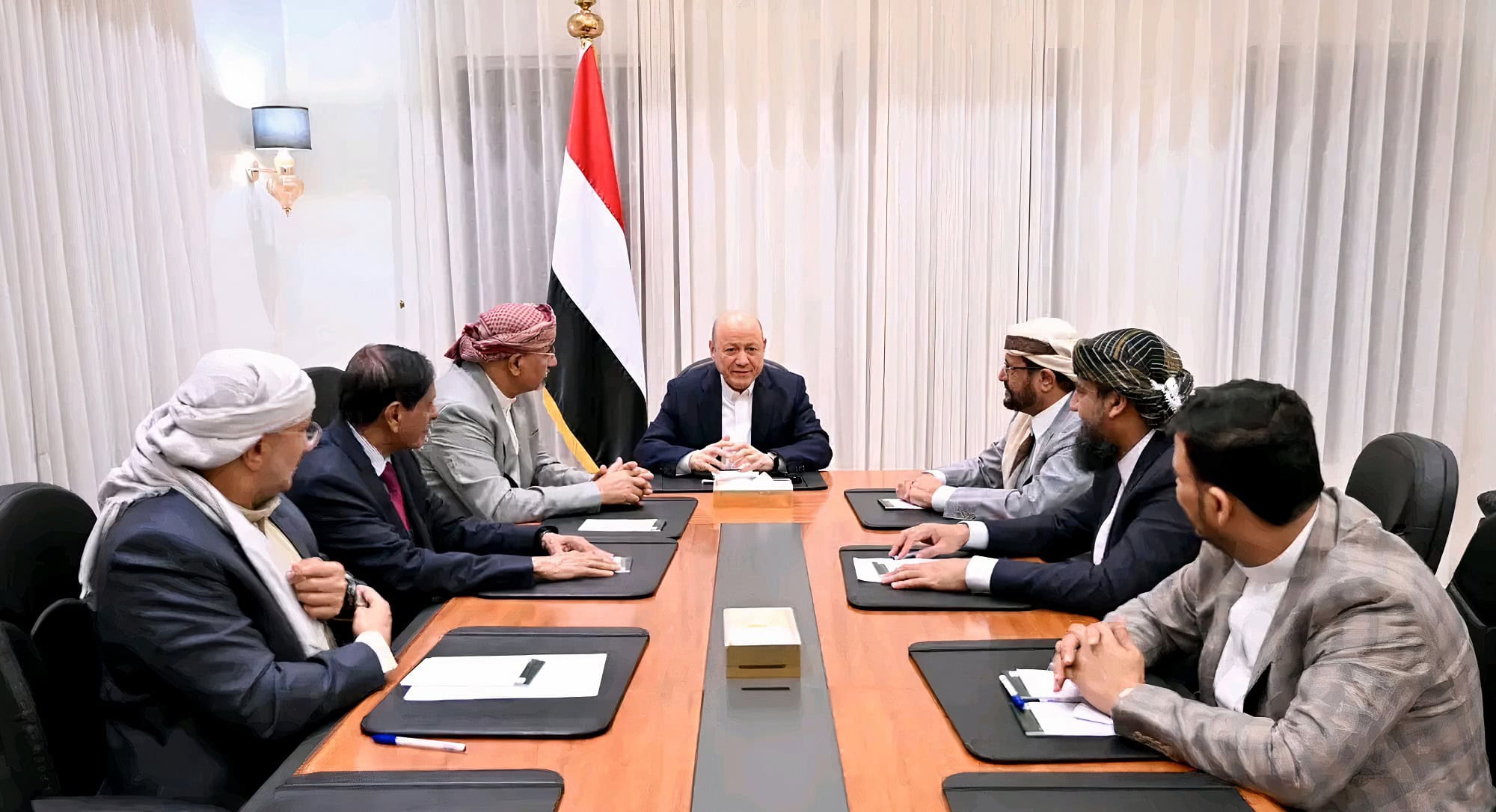
From one of the Mahri Language Center’s events, October 2021 (quoted from Al-Mashhad website)
آخر تحديث في: 09-10-2023 الساعة 8 صباحاً بتوقيت عدن
More than 10 years ago, UNESCO issued the ’World Atlas of Languages‘ for those languages which are under threat of dying out, including Mehri.
Abdullah Al-Shadli (South24)
In South Yemen, the people of Al-Mahra Governorate have enjoyed a unique and historical heritage. They have a distinctive feature represented in ’Mehri’, a spoken language limited to Mahri locals. Notably, ’Mehri‘ lacks an alphabetic writing system that can protect it from the threat of dying out. ‘Socotri’, an ancient language spoken by the people of Socotra archipelago, faces a similar threat. Like in the case of Socotri, successive generations have helped preserve ‘Mehri by inheriting it from their ancestors and learning it.
There are more than 250,000 people who speak Mehri inside and outside the governorate, according to the University of Leeds’s Professor Saeed Saad Njadan Al-Qumairi, who is the Director of the Mehri Language Center for Research and Studies.
He told ’South24 Center‘ that Mehri is classified as one of the most important six languages that belong to the modern South Semitic language family which faces the threat of dying out. Every two weeks, one of 7,000 languages around the world vanishes. Half of these languages are expected to die out by the end of the current century, including Mehri and the other five languages, according to experts.
What is ’Mehri'?
Al-Qumairi said “Mehri is an old Arab language and part of the Semitic language family. In particular, it is the language of the Arab Peninsula. It is spoken by Mehris, some tribes, and other factions in the governorate as well as Dhofar in Oman whose people have a lineage relationship with Mahra bin Haydan bin Amr bin Lahaf bin Qadaah and Mallik bin Himyar.”
He pointed out that “Mehri has gone beyond the boundary of Al-Mahra to become the language fabric of all neighboring towns inhabited by some Mahri tribes.”
Al-Qumairi described ’Mehri‘ as being an “integrated language museum” which contains vocabulary from all Semitic languages such as South Arabian, Akkadian, Aramaic, and other ancient Arab languages.
Hassan Al-Fadli, Professor of Linguistics and Deputy Dean for Postgraduate Studies at the Faculty of Arts at Hadramout University, told ’South 24 Center‘ that “Mehri is characterized by its rich cultural and linguistic heritage. It is one of the six modern South Arabian languages which spread in Al-Mahra, Socotra and Oman.”
Similar languages
As for the resemblance between Mehri and some other languages such as ’Socotri‘ and ’Shehri‘, Al-Qumairi said that all of them descend from one origin and have common roots of verbs, whether triple or quadruple.
In terms of the most remarkable differences between ’Mehri‘ and ’Arabic‘, Al-Qumairi said: “Mehri has the same Arabic letters in addition to some native sounds. We can say that Mehri consists of 33 letters and sounds.”
He pointed to the major similarity among all Semitic languages. However, he mentioned some of the differences between his Ph.D. thesis and some of his research papers written in English. He noted that Professor Amer Fael Balhaf in his book ’Al-Mahra in the Sources of Language and Literature‘ has written at length about this language.
Al-Qumairi cited examples of the differences between Mehri and Arabic as illustrated below:
The third person pronoun: In his book ’The Semites and their Languages”, Hassan Zaza wrote about the phonetic development of some whistling letters such as “Sin” which replaced ‘Haa’” in the separate pronoun. For example, the separate pronoun “Hu” in classical Arabic is pronounced “Su” in South Arabian and "Shu" in the Babylonian and Assyrian languages. Such a case exists in Mehri as the third person feminine singular pronoun “Hi” is pronounced as “Si”. Likewise, the plural feminine third person pronoun “Honna” in classical Arabic is pronounced as “Sin”.
The transitiveness form: According to a study by Dr. Mahmoud Hijazy, one of the main features of the ancient ’Sabaean‘ was the use of “Haa” in a number of morphological formulas. The transitiveness form “Afaal” in Northern Arabic is equivalent to “Hafaal” in ’Sabaean‘. This feature is still common in Mehri as “Hebhol”, which means the food is ripe.
The articulation of “Dad”: Sibawayh said that the articulation of ancient “Dad” is between the first edge of the tongue and the molars. Ibn Jinni adopted the same opinion adding that: “If you want more stress on the letter, you can use the right or left side.” This completely applies to the Mehri Dad which is an ancient one. It isn’t like “Dad” in modern Arabic which is a dental gingival sound with an explosive amplified pause.
In Ethiopia, the Amharic language is the second official language in the country. It is a Semitic language consisting of 33 letters. It is believed that Amharic is closer to ’Mehri‘ than other languages including Arabic. Both of them have the same number of letters.
Professor Hassan Al-Fadli agreed with this view, saying: “The Amharic and Mehri languages share some words, vocabulary, and linguistic structures. Both of them belong to the Semitic branch of the Afro-Asian language family.”
Despite sharing some common aspects, Al-Fadli stressed that “there are differences in the phonetic system, and the grammatical and morphological rules between the two languages.” He noted that there is big convergence between Mehri and the Hadrami dialect (has an Arab origin) in the coast of Hadramout. The similarities include vocabulary and some morphological aspects.
Examples of Mehri
In an interview with the ’South24 Center‘, Mahri media activist Hazza’ Al-Sulaimi gave some examples of Mahri words and sentences and their equivalents, as follows:
Mehri word/sentence | The equivalents in English |
أمْولْ Amol | An imperative verb to urge doing something |
ذَيْامُول Diamol | Muscular Present simple tense |
تَامُولْ Tamol | Feminine Present simple tense |
أصرومة Asromah | Now |
مْغُوُرْنْ Megwarn | The next |
هَاوِيْلَنْ Hawelen | Before something happens |
ذَرْيِهْمْ Zarihem | Money |
حَاصْنْ أو مَنْقَلاتْ Hasn or Mankalat | House |
حَصّوْنْ Hason | Houses |
مَذوسِيت Mazoset | School |
مَذَوْرَسْ Mazoras | Schools |
هُوهْ أو تِي هُوهْ Hu or Te Hu | The first person pronoun which refers to both genders |
هِيْتْ Hit | It means “you” and refers to the feminine singular |
تِامْ أو هَامْ Tam or Ham | It means “you” to refer to the muscular plural |
سِيْهْ Seeh | It is used to refer to the feminine singular |
تَانْ أو سَانْ Tan or San | It is used to refer to the feminine plural |
ذومه حاصِن قي د Dhuma Hasin Qi Di | This is a beautiful house |
شوقاك براك اطريت حمك تفكِيك لي Shoqak brak atrit hamak Tafkik li | I got into trouble, please help me |
The importance of Mehri
The interest in Mehri hasn’t been limited to Mahri or Arab researchers. This language has also attracted many foreign researchers, according to Prof. Hassan Al-Fadli. He said: “The interest of non-Arab experts in Mehri began in the 19th century.”
He added: “In general, such a foreign interest is due to the Mehri diversity and its contribution to understanding the impact of human pluralism on communities.”
Al-Fadli believes that “the current importance of Mehri is represented in many aspects, especially research and scientific studies. The history, the development, and the impact of the language can be discovered. Moreover, scientific studies can enrich knowledge about the language and the Mahri heritage.”
Commenting on the role played by language to preserve the history of the Mahri culture, literature, and art, Al-Qumairi said: “Mehri has played a big role in maintaining identity and culture. For example, Mehri poetry with all its variety is the main bearer of Mahri culture. Poetry has helped to further circulate the language. Mahri people adore and practice poetry, which is immortalised in the souls and minds of all Mehri speakers.”
Challenges
More than 10 years ago, UNESCO issued the ’World Atlas of Languages’ for those languages which are under threat of dying out, including Mehri. The common denominator among them is that they are all verbal languages that have no alphabetic writing system.
Prof. Al-Fadli believes that the lack of a unified officially recognized writing system for Mehri may impact its sustainability and threaten its very existence. He said that the formal alphabetic system plays an important role in documenting a language and disseminating it among generations. It also helps with communication, writing, publishing, and documentation.
Despite the importance of the need for setting up a writing system for Mehri, Al-Fadli believes that the lack of it doesn’t necessarily mean that the language will vanish. He noted that other verbal languages have survived for thousands of years without a writing system. According to him, language can be preserved by verbal transmission and by using it in daily life and social communication among speakers.
Al-Qumairi mentioned some of the current challenges that Mehri faces, including “the lack of governmental and social interest, and the narrow-minded concepts adopted by some who believe that studying this language is limited to local areas”. He pointed out that Mehri has not gone beyond its geographical scope as the Yemeni universities and research institutions have not made much effort to study this national heritage.
Asked about the decline of ’Mehri‘ due to the growing use of technology, Al-Qumairi said: “There has been no big decrease in usage of Mehri. There is a slight natural decline due to the linguistic overlaps and the effect of modernization and globalization.”
Efforts
Al-Qumairi deems the setting up of the Mehri Language Center for Research and Studies on October 2, 2017, under his leadership, as one of the most important initiatives and achievements for preserving Mehri. He noted that Mahra people celebrate the anniversary of founding of the center every year and call it “The Mehri Day”.
He talked about the efforts of the center, saying: “It established the first steps to create a Mehri writing system and document its vocabulary that has been verbally transmitted from one generation to another.”
He pointed out that “the center works relentlessly to document the Mehri popular heritage, traditions, literature, and poetry. It has brought out many scientific researches and useful translations of foreign works related to Al-Mahra, including the language, land and culture.”
According to the linguistic expert, “the center organized several conferences to study Mehri. It participated in relevant seminars and international conferences. It has also created local, regional and international partnerships to consolidate the language."
On May 8, 2023, the closing statement of the five-day Southern Consultation and Dialogue Meeting, held in Aden, stressed on the importance of respecting the historical and cultural distinctiveness of different Southern areas and to officially adopt the Mehri and Socotri languages in their areas.
Journalist at South24 Center for News and Studies
Note: This is a translated version of the original text written in Arabic

قبل 3 أشهر